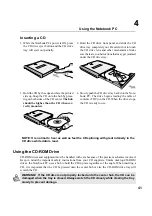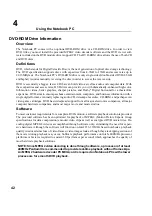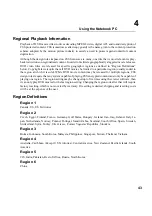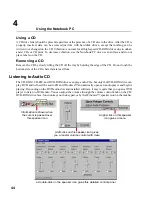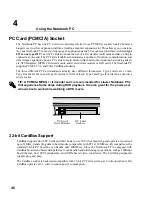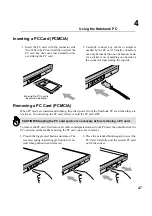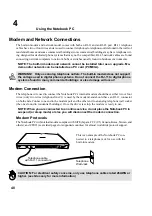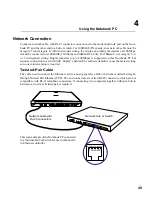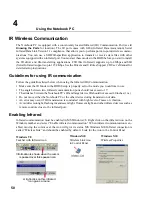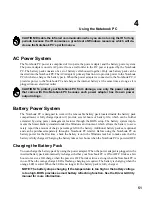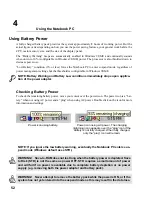
55
Using the Notebook PC
4
Thermal Power Control
There are three power control methods for controlling the Notebook PC’s thermal state. These power
control cannot be configured by the user and should be known in case the Notebook PC should enter
these states. The following temperatures represent the chassis temperature (not CPU).
• The fan turns ON for active cooling when temperatures are close to the safe upper limit.
• The processor throttles (decrease CPU speed) for passive cooling when temperature exceeds the safe
upper limit.
• The system shut down for critical cooling when temperature exceeds the maximum safe upper limit.
System Memory Expansion
Under some circumstances, you may find additional memory is required. This is particularly true as
applications become more complex. Expanding system memory is one method of increasing system
performance by decreasing hard disk access. The Notebook PC comes with 64-bit high speed SDRAM
built-in. One standard 144-pin SO-DIMM (Small Outline Dual Inline Memory Module) socket is avail-
able for system memory expansion using common 3.3 Volt 100MHz SDRAM SO-DIMM modules.
Currently, SO-DIMM memory sizes are available in 64MB, 128MB, or 256MB for each module. The
BIOS automatically detects the amount of memory in the system and configure CMOS accordingly
during the POST (Power-On-Self-Test) process. There is no hardware or software (including BIOS)
setup required after the memory is installed. Only purchase expansion modules from your authorized
retailer to ensure compatibility and reliability. The memory module must be installed by a certified
Notebook PC technician.
CAUTION! This Notebook PC does not support EDO DRAM.
Processor Upgrades
Visit your authorized service center or retailer for upgrades. The Notebook PC uses an Intel
®
micro-
PGA2 socket in order to support future processor upgrades. Faster processors are being developed
every day.
Summary of Contents for T9A
Page 11: ...10 About This User s Manual Notes For This Manual 1 Introducing the Notebook PC ...
Page 13: ...12 Top Side Bottom Side Left Side Right Side Rear Side Front Side 2 KNOWING THE PARTS ...
Page 81: ...80 APPENDIX Internal Modem Compliancy Glossary Owner Information ...
Page 84: ...84 APPENDIX A ...
Page 91: ...91 APPENDIX A ...

